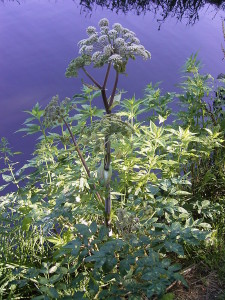Herb farm apiary
A friend and I were lucky to be invited to put some hives on a local herb farm next season. Tucked away between the country roads, the farm is about 400 hectares growing a fascinating selection of herbs for their drying and oil production. Because extensive herb growing is so rare in this country, we’re not quite sure what to expect. But we do know that the area is rich in bumblebees so that should prove an interesting distraction.
My usual bible of plants and honeybees, the wonderful Plants for Bees, isn’t much help for once! The herbs are so rarely grown in quantity in Britain that not much is known about their usefulness to honeybees here.
The most interesting may be Angelica. One Chinese vendor says that the honey from angelica is:
rare and valuable …. Its colour varies from rich brown to brownish with a red tint, sometimes … with light greenish tint … It has a fairly sharp specific aroma, some bitterness and leaves a well pronounced bonbon aftertaste.
Angelica usually flowers in June/July, but the grower suggests that the crop on the herb farm flowers early.
The mint should prove interesting. It is a very rare old English variety (Black Mitcham) destined for chocolate! Like most mint, it flowers late in the year and, according to Plants for Bees, mint flowers can yield honey where it grows in quantity (rare in this country). August should prove interesting, then, as the nectar flow is usually long gone here by then and the bees should be able to focus on the mint. The honey is reported to be amber in colour with a minty taste which disappears with time (rather than thyme).
There is some coriander. Unlike its cooking components, the nectar seems to yield a delicate honey that is light amber and crystallises quite quickly. I think its flowering time is likely be quite late in the bee season.
Lovage is also grown and seems to be popular with bees, but I cannot find any reports of the honey produced.
There is also lots of chamomile, but it is of no interest to bees and, I’m told, doesn’t even produce seeds. The parsley will flower in its second year, but may be harvested before it gets to that stage.
I will let you know what happens and try to arrange some pollen analysis to see if the bees are working the herbs or finding more interesting wild plant and tree honey – not to mention whatever other crops farmers may be growing in the vicinity. It may of course be a race between the herb harvesting and flowering.
Turlough
Vita’s Guest Beekeeper Blogger

